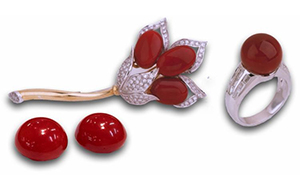Chris Blakeslee has experience at Athleta and Alo Yoga. Kendra Scott will remain on board as executive chair and chief visionary officer.
CIBJO releases first Blue Book for coral
CIBJO, the World Jewellery Confederation, has debuted its first Blue Book on coral, defining acceptable trade and industry practices and nomenclature for this organic material.
Milan--CIBJO, the World Jewellery Confederation, has debuted its first Blue Book on coral, defining acceptable trade and industry practices and nomenclature for coral.

The full Coral Book, compiled by the CIBJO Coral Commission, can be downloaded from the CIBJO website here.
It marks the sixth in the Blue Book series, joining diamonds, gemstones and pearls--all three of which have been recently updated--as well as precious metals and gemological laboratories. Each is compiled and updated by relevant CIBJO Commissions, whose members include representatives of trade organizations and laboratories that are active in the industry.
The Coral Book includes terms that should be used to describe coral and disclose treatments, and those that should be used to define associated artificial products. Methods to maintain the quality of coral jewelry are listed, as are the various types of different precious coral species.
While the Blue Book gives guidelines for international trade practices surrounding coral, jewelers in the United States need to be aware of the laws here concerning this organic, and endangered, material.
The JVC’s Sara Yood told National Jeweler that coral currently is subject to regulation in the U.S.
Requirements include declaration and licensing permits from the U.S. Fish & Wildlife Service (USFWS) for importation and exportation, as well as additional declarations from U.S. Customs and Border Protection upon import. Certain coral materials are prohibited altogether.
There’s also the United Nations’ Convention on International Trade in Endangered Species (CITES), which is mentioned in CIBJO’s Coral Book. This is an international treaty between more than 175 nations, including the U.S., to ensure that international trade in species of wildlife and plants does not threaten their survival. There are three levels of control under it.
In the United States, CITES is implemented through the Endangered Species Act, which provides the framework for prohibiting trade in the country and prevents harvesting, import, export or sale of listed endangered or threatened species.
Coral reefs currently are one of the most endangered ecosystems on the planet today. There are two types of coral, reef and deep sea, and the Yood said that the industry generally uses deep
These are regulated under international law as CITES Appendix II, which means they may become extinct unless protected. Some other species of red corals that are also used in the jewelry trade are listed as CITES Appendix III, indicating they are subject to controls.
“If a jeweler is purchasing coral with the intent to export for sale, it is always important to verify that the seller has the appropriate CITES permit for the coral,” Yood said in an email. “The jeweler will need to provide a copy of the CITES document used to import that specimen in order to get a re-export certificate from USFWS. Jewelers should always check with USFWS before importing/exporting animal products.”
The Latest

The credit card companies’ surveys examined where consumers shopped, what they bought, and what they valued this holiday season.

Kimberly Miller has been promoted to the role.

How Jewelers of America’s 20 Under 40 are leading to ensure a brighter future for the jewelry industry.

The “Serenity” charm set with 13 opals is a modern amulet offering protection, guidance, and intention, the brand said.


“Bridgerton” actresses Hannah Dodd and Claudia Jessie star in the brand’s “Rules to Love By” campaign.

Founded by jeweler and sculptor Ana Khouri, the brand is “expanding the boundaries of what high jewelry can be.”

Roseco’s 704-page catalog showcases new lab-grown diamonds, findings, tools & more—available in print or interactive digital editions.

The jewelry manufacturer and supplier is going with a fiery shade it says symbolizes power and transformation.

The singer-songwriter will make her debut as the French luxury brand’s new ambassador in a campaign for its “Coco Crush” jewelry line.

The nonprofit’s new president and CEO, Annie Doresca, also began her role this month.

As the shopping mall model evolves and online retail grows, Smith shares his predictions for the future of physical stores.

The trade show is slated for Jan. 31-Feb. 2 at The Lighthouse in New York City's Chelsea neighborhood.

January’s birthstone comes in a rainbow of colors, from the traditional red to orange, purple, and green.

The annual report highlights how it supported communities in areas where natural diamonds are mined, crafted, and sold.

Footage of a fight breaking out in the NYC Diamond District was viewed millions of times on Instagram and Facebook.

The supplier has a curated list of must-have tools for jewelers doing in-house custom work this year.

The Signet Jewelers-owned store, which turned 100 last year, calls its new concept stores “The Edit.”

Linda Coutu is rejoining the precious metals provider as its director of sales.

The governing board welcomed two new members, Claire Scragg and Susan Eisen.

Sparkle with festive diamond jewelry as we celebrate the beginning of 2026.

The master jeweler, Olympian, former senator, and Korean War veteran founded the brand Nighthorse Jewelry.

In its annual report, Pinterest noted an increase in searches for brooches, heirloom jewelry, and ‘80s luxury.

Executive Chairman Richard Baker will take over the role as rumors swirl that a bankruptcy filing is imminent for the troubled retailer.

Mohr had just retired in June after more than two decades as Couture’s retailer liaison.

Shekhar Shah of Real Gems Inc. will serve as president of the Indian Diamond & Colorstone Association in 2026.

This year’s good luck charm features the mythical horse Pegasus, and is our first Piece of the Week of the new year.


























